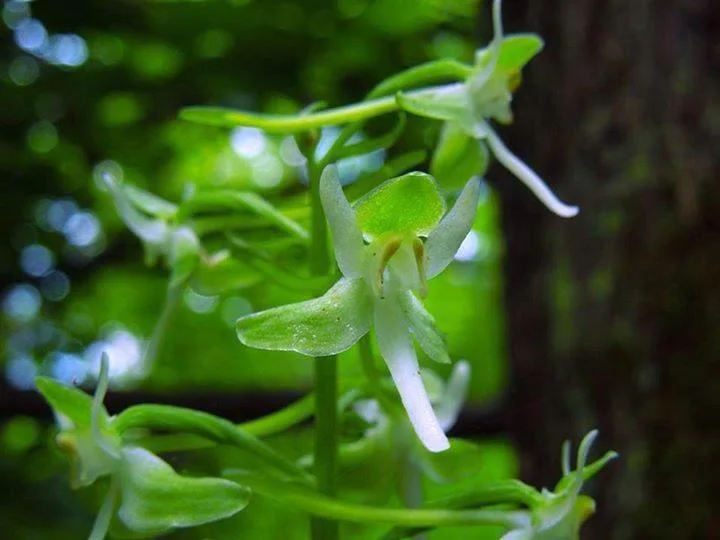In the northern temperate regions of North America, late June marks the beginning of what I like to call orchid season. If you're lucky you may stumble across one of these rare beauties in full bloom. Their diversity in shape and size are mainly a result of the intricate evolutionary relationships they have formed with their pollinators. I spend much of my time botanizing trying to locate and photograph these botanical curiosities and any time I get to meet a new species is a very special time indeed.
Take the round leaved orchid (Platanthera orbiculata) for example. For years I have only known this species as two round leaves that are slightly reminiscent of the phaleanopsis orchids you see for sale in nurseries and grocery stores. The leaves can be quite large too. With their glossy appearance, they are the easiest way to locate this plant.
When conditions are right and the plants have enough stored energy they will begin to flower. Rising from the middle of the pair of leaves is a decent sized inflorescence loaded with greenish white flowers. The flowers are interesting structures. Not particularly colorful, they have a long white lip and considerable green nectar spurs. There are said to be two varieties of this species, each being characterized by the length of the nectar spur. Unlike many orchids that offer no reward to pollinators, P. orbiculata produces nectar. The flowers are pollinated by noctuid moths, which is probably why they are white in color. Whereas most lepidopteran pollinated orchid attach their pollinia to the proboscis of the butterfly or moth, P. orbiculata attaches its pollinia to the eyes of visiting moths.
If this isn't strange enough, the pollinia themselves have some of their own intriguing adaptations. Visiting moths take a certain amount of time to successfully access the nectar from the nectar spur. If the plant is to avoid wasting precious pollen on itself, then it must find a way to delay this process. The pollinia are the solution to this. When first attached to the eyes, the pollinia stick straight up. This keeps them away from the female parts of the plant as the moth feeds. Only after enough time has elapsed will the stalks of the pollinia begin to bend forward. At this point the moth will hopefully have moved on to the flowers of an unrelated individual. Pointing straight forward, they are now perfectly positioned to transfer pollen.
Like all orchids, P. orbiculata relies on specialized mycorrhizal fungi for germination and survival. At the beginning of its life, P. orbiculata relies solely on the fungi for sustenance. Once it has enough energy to produce leaves it will repay the fungi by providing carbohydrates. However, the relationship is not over at this point. Every spring, P. orbiculata produces a new set of leaves as well as a whole new root system. The fungi supply a lot of energy for this process and if the plant is disturbed (ie. dug up by greedy poachers) or browsed upon, it is likely that it will not recover from the stress and it will die. The mycorrhizal fungi it relies on live on rotting wood so finding well rotted logs is a good place to start searching for this species. With declining populations throughout much of its range, it is important to remember to enjoy it where it grows. Leave wild orchids in the wild!
Further Reading: [1] [2] [3] [4]



